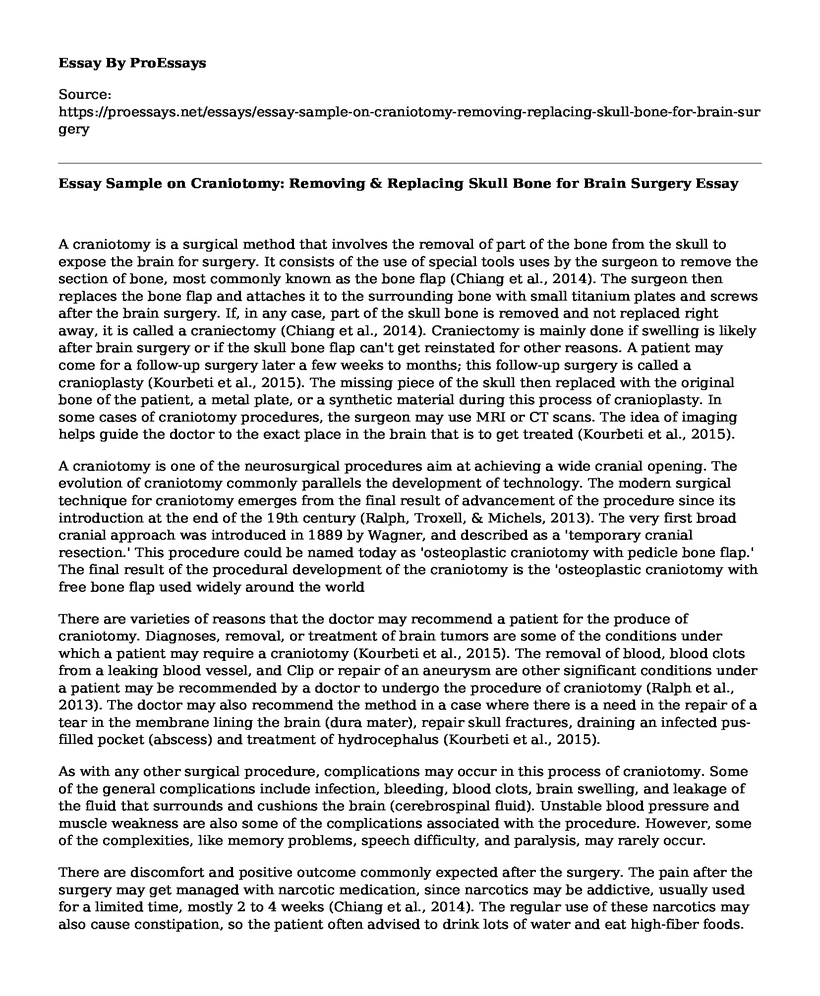A craniotomy is a surgical method that involves the removal of part of the bone from the skull to expose the brain for surgery. It consists of the use of special tools uses by the surgeon to remove the section of bone, most commonly known as the bone flap (Chiang et al., 2014). The surgeon then replaces the bone flap and attaches it to the surrounding bone with small titanium plates and screws after the brain surgery. If, in any case, part of the skull bone is removed and not replaced right away, it is called a craniectomy (Chiang et al., 2014). Craniectomy is mainly done if swelling is likely after brain surgery or if the skull bone flap can't get reinstated for other reasons. A patient may come for a follow-up surgery later a few weeks to months; this follow-up surgery is called a cranioplasty (Kourbeti et al., 2015). The missing piece of the skull then replaced with the original bone of the patient, a metal plate, or a synthetic material during this process of cranioplasty. In some cases of craniotomy procedures, the surgeon may use MRI or CT scans. The idea of imaging helps guide the doctor to the exact place in the brain that is to get treated (Kourbeti et al., 2015).
A craniotomy is one of the neurosurgical procedures aim at achieving a wide cranial opening. The evolution of craniotomy commonly parallels the development of technology. The modern surgical technique for craniotomy emerges from the final result of advancement of the procedure since its introduction at the end of the 19th century (Ralph, Troxell, & Michels, 2013). The very first broad cranial approach was introduced in 1889 by Wagner, and described as a 'temporary cranial resection.' This procedure could be named today as 'osteoplastic craniotomy with pedicle bone flap.' The final result of the procedural development of the craniotomy is the 'osteoplastic craniotomy with free bone flap used widely around the world
There are varieties of reasons that the doctor may recommend a patient for the produce of craniotomy. Diagnoses, removal, or treatment of brain tumors are some of the conditions under which a patient may require a craniotomy (Kourbeti et al., 2015). The removal of blood, blood clots from a leaking blood vessel, and Clip or repair of an aneurysm are other significant conditions under a patient may be recommended by a doctor to undergo the procedure of craniotomy (Ralph et al., 2013). The doctor may also recommend the method in a case where there is a need in the repair of a tear in the membrane lining the brain (dura mater), repair skull fractures, draining an infected pus-filled pocket (abscess) and treatment of hydrocephalus (Kourbeti et al., 2015).
As with any other surgical procedure, complications may occur in this process of craniotomy. Some of the general complications include infection, bleeding, blood clots, brain swelling, and leakage of the fluid that surrounds and cushions the brain (cerebrospinal fluid). Unstable blood pressure and muscle weakness are also some of the complications associated with the procedure. However, some of the complexities, like memory problems, speech difficulty, and paralysis, may rarely occur.
There are discomfort and positive outcome commonly expected after the surgery. The pain after the surgery may get managed with narcotic medication, since narcotics may be addictive, usually used for a limited time, mostly 2 to 4 weeks (Chiang et al., 2014). The regular use of these narcotics may also cause constipation, so the patient often advised to drink lots of water and eat high-fiber foods. The patient should consult the surgeon before taking nonsteroidal anti-inflammatory drugs (NSAIDs) like ibuprofen, Advil, Motrin, and Nuprin since they may cause bleeding and interfere with bone healing. Medicine may be prescribed to prevent seizures (Chiang et al., 2014). However, some patients may develop side effects like balance problems and rashes from the use of anticonvulsants. In such a case, blood samples are taken to monitor the drug levels and manage the side effects. There is a good chance that weakness or paralysis in a limb caused by pressure on the brain may improve following surgery.
References
Chiang, H. Y., Kamath, A. S., Pottinger, J. M., Greenlee, J. D., Howard, M. A., Cavanaugh, J. E., & Herwaldt, L. A. (2014). Risk factors and outcomes associated with surgical site infections after craniotomy or craniectomy. Journal of neurosurgery, 120(2), 509-521. Retrieved from
https://thejns.org/view/journals/j-neurosurg/120/2/article-p509.xml
Kourbeti, I. S., Vakis, A. F., Ziakas, P., Karabetsos, D., Potolidis, E., Christou, S., & Samonis, G. (2015). Infections in patients undergoing craniotomy: risk factors associated with post-craniotomy meningitis. Journal of neurosurgery, 122(5), 1113-1119. Retrieved from
https://thejns.org/view/journals/j-neurosurg/122/5/article-p1113.xml
Ralph, J. D., Troxell, T. N., & Michels, M. (2013). U.S. Patent No. 8,460,346. Washington, DC: U.S. Patent and Trademark Office. Retrieved from
https://www.tandfonline.com/doi/abs/10.1080/02688697.2019.1672860
Cite this page
Essay Sample on Craniotomy: Removing & Replacing Skull Bone for Brain Surgery. (2023, Apr 04). Retrieved from https://proessays.net/essays/essay-sample-on-craniotomy-removing-replacing-skull-bone-for-brain-surgery
If you are the original author of this essay and no longer wish to have it published on the ProEssays website, please click below to request its removal:
- Case Study: Susan Summers and Cushing Syndrome
- Critical Evaluation of Auto Liberation by Knutson Article
- Culturally Competent Nursing: Respecting Diversity in Care - Essay Sample
- Research Paper on PCOS: Complex Pathophysiology and Diagnosis
- COVID-19: Global Pandemic With 166 Countries Affected - Essay Sample
- Research Paper on Hourly Rounding: Enhancing Patient Care in Hospitals
- Essay Example on Nursing Leadership: Essential for Quality Healthcare







